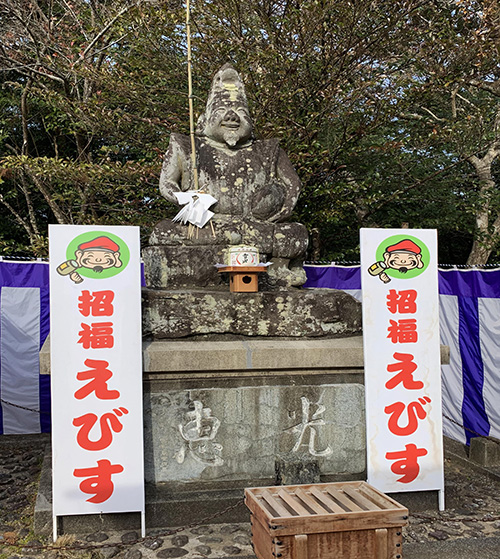

しばらく「民藝」についてブログで考えていましたが、
運動としての民藝は透明性・普遍性を持った思想や観念に昇華できず、
結局は創始者たちの嗜好性選別に留まってしまったように思います。
だから150年を超える北海道の開拓民の生み出したものを
民藝としては無視するしかなかったように思う。
北海道民の民藝不在違和感に対してアイヌ民族を対置するのでは、違和感が強い。
どうもそんな思いが強まって、むしろ民俗をもっと感じさせてくれるものを
各地の探訪で求めていたように思います。
写真はきのうまで触れていた少彦名神社と同じ南予の大洲神社。
北海道では「えびす講」というのはあまり根付いていないように思いますが
こちらの神さまは大国主命と事代主命(えびす様)。
このえびす様は言うまでもなく商売繁盛・福徳来家の神さまであり、
愛媛県で唯一の「十日えびす祭」が行われることで知られている。
たまたま遭遇したのでさっそくに神札を購入させていただいた(笑)。
いかにも現世利益という民のホンネに即しているので
愛媛県内全県から多くの参拝者が来訪するのだとされていました。
こういった「民俗性」というものに強く惹かれる。
素朴な民の願望に対してごく自然に対応したえびす様のお姿は
どこでも大体「えびす顔」をされていて、そのご尊顔だけでもありがたい。
民藝運動では素朴な各地域の民具に対して、優れた芸術者たちが
その感受性でもって「評価」を与える、という側面が強調される。
その評価軸自体はいいと思うけれど、やや気取りが強い。
いかにも柳宗悦氏というイデオローグの選別感覚に依存する。
普遍性という部分では限界が露呈せざるを得ない。
一方で現世利益を幅広く説くえびす様は圧倒的な「肯定力」がある。
どのような民人に対してもこぼれるばかりのえびす顔で接してくれる。
日本人としての心性の基底ではこうした「肯定力」が大きいのではないか。
そもそもアジア世界の多様な地域からこの列島社会に参入してきた多くの民がいた。
そういった人々が縄文由来の人々と混血していったとき、
ベースになったのはやはりこうした「肯定力」だったと思う。
出雲の国づくり神話世界から神代の時代での神武神話で成立していった
この国の王権の根幹部分でもこうした「肯定力」が働いていたのではないか。
だから強権的支配構造はこの列島社会ではあまり根付かなかったように思う。
北海道では民俗としての「えびす」様はあまり広がりがない。
多分民俗として「ニシン御殿」のようなものがそれに相応するように思う。
まことに生々しい現世利益の象徴痕跡のようだけれど、
あの存在に対して入口付近に「鳥居」でも建てれば、特異だけれど
北海道らしい民俗はすでに形成されていて、その精神性は残っている
というようにも思える。民藝と民俗の方程式、興味深いです。
English version⬇
[Folk art and folk equations Archipelago folk culture exploration]
I’ve been thinking about “Mingei” on my blog for a while,
Mingei as a movement cannot be sublimated into ideas and ideas with transparency and universality.
In the end, I think I was limited to selecting the tastes of the founders.
That’s why the products of the pioneers of Hokkaido for over 150 years
I think that Mingei had no choice but to ignore it.
It is very uncomfortable to confront the Ainu people against the uncomfortable feeling of the absence of Mingei from the people of Hokkaido.
It seems that such feelings are strengthened, and rather something that makes us feel more folk.
I think I was looking for it when I visited each place.
The photo is Ozu Shrine in Nanyo, which is the same as Sukunahikona Shrine that I touched on until yesterday.
I don’t think “Ebisu-ko” has taken root in Hokkaido.
This god is Okuninushi and Kotoshironushi (Ebisu-sama).
Needless to say, this Ebisu-sama is the god of prosperous business and the Fukutoku visitor.
It is known that the only “Toka Ebisu Festival” in Ehime Prefecture is held.
I happened to encounter it, so I immediately bought a god card (laughs).
Because it really matches the real interests of the people of this world
It was said that many worshipers came from all prefectures in Ehime prefecture.
I am strongly attracted to this kind of “folklore”.
The appearance of Ebisu who responded naturally to the wishes of the simple people
I’m almost everywhere with an “Ebisu face”, and I’m grateful for that precious face alone.
In the Mingei movement, excellent artists are used for the simple folk implements of each region.
The aspect of giving “evaluation” by its sensitivity is emphasized.
I think the evaluation axis itself is good, but it’s a little pretentious.
It really depends on the selection sense of the ideologue called Mr. Soetsu Yanagi.
There is no choice but to expose the limits in the part of universality.
On the other hand, Ebisu, who preaches the interests of this world widely, has overwhelming “affirmation”.
He treats any civilian with a spilling face.
I think this kind of “affirmation” is great at the basis of the Japanese spirit.
In the first place, there were many people who entered this archipelago society from various regions of the Asian world.
When those people were mixed with people from the Jomon period,
I think it was this kind of “affirmation” that became the basis.
Izumo no Kunizukuri Myth It was established from the world to the Shinbu myth in the age of the Gods.
Perhaps this kind of “affirmation” was working at the core of the kingship of this country.
Therefore, I think that the powerful rule structure did not take root in this archipelago society.
In Hokkaido, “Ebisu” as a folk is not so widespread.
Perhaps as a folklore, something like “Nishin Goten” seems to correspond to it.
It seems to be a symbolic trace of the vivid worldly interests,
It would be peculiar if you built a “Torii” near the entrance to that existence.
Hokkaido-like folklore has already been formed, and its spirituality remains.
It seems like that. The folk and folk equations are interesting.
Posted on 1月 17th, 2022 by 三木 奎吾
Filed under: こちら発行人です, 日本社会・文化研究







コメントを投稿
「※誹謗中傷や、悪意のある書き込み、営利目的などのコメントを防ぐために、投稿された全てのコメントは一時的に保留されますのでご了承ください。」
You must be logged in to post a comment.